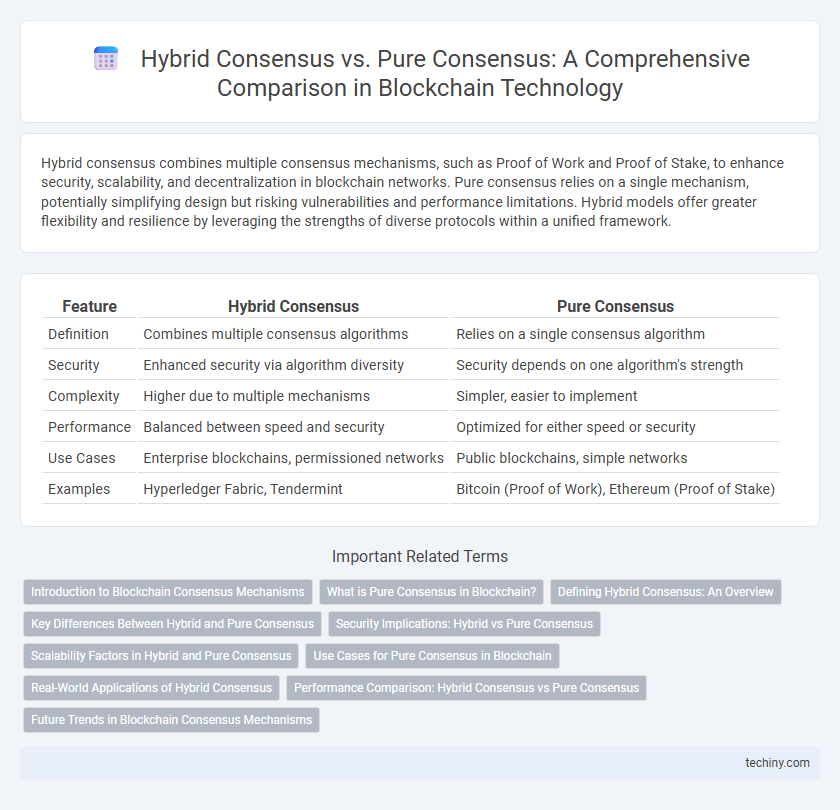Hybrid consensus combines multiple consensus mechanisms, such as Proof of Work and Proof of Stake, to enhance security, scalability, and decentralization in blockchain networks. Pure consensus relies on a single mechanism, potentially simplifying design but risking vulnerabilities and performance limitations. Hybrid models offer greater flexibility and resilience by leveraging the strengths of diverse protocols within a unified framework.
Table of Comparison
| Feature | Hybrid Consensus | Pure Consensus |
|---|---|---|
| Definition | Combines multiple consensus algorithms | Relies on a single consensus algorithm |
| Security | Enhanced security via algorithm diversity | Security depends on one algorithm's strength |
| Complexity | Higher due to multiple mechanisms | Simpler, easier to implement |
| Performance | Balanced between speed and security | Optimized for either speed or security |
| Use Cases | Enterprise blockchains, permissioned networks | Public blockchains, simple networks |
| Examples | Hyperledger Fabric, Tendermint | Bitcoin (Proof of Work), Ethereum (Proof of Stake) |
Introduction to Blockchain Consensus Mechanisms
Hybrid consensus mechanisms combine features of both proof-of-work (PoW) and proof-of-stake (PoS) to enhance security, scalability, and energy efficiency in blockchain networks. Pure consensus models rely solely on one approach, such as PoW or PoS, which can limit adaptability and performance under varying network conditions. Implementing hybrid consensus improves decentralization and transaction throughput while mitigating the weaknesses inherent in single-protocol systems.
What is Pure Consensus in Blockchain?
Pure consensus in blockchain refers to a consensus mechanism where all participating nodes strictly follow a single protocol without combining different consensus algorithms. It typically relies on well-known models like Proof of Work (PoW) or Proof of Stake (PoS) to validate transactions and secure the network. Pure consensus ensures uniform agreement across the network, enhancing security but sometimes sacrificing scalability and flexibility compared to hybrid consensus models.
Defining Hybrid Consensus: An Overview
Hybrid consensus combines multiple consensus mechanisms, such as Proof of Work (PoW) and Proof of Stake (PoS), to enhance blockchain security, scalability, and energy efficiency. This approach leverages the strengths of each consensus type while mitigating their individual weaknesses, resulting in improved transaction throughput and resistance to attacks. Hybrid consensus models are increasingly adopted in enterprise and public blockchains to balance decentralization with performance.
Key Differences Between Hybrid and Pure Consensus
Hybrid consensus combines elements of proof-of-work (PoW) and proof-of-stake (PoS) to enhance security and scalability, while pure consensus relies on a single mechanism like PoW or PoS for decision-making. Hybrid models improve energy efficiency and reduce vulnerabilities by leveraging multiple validation methods, whereas pure consensus systems may face limitations such as high energy consumption or centralization risks. Key differences include the hybrid approach's flexibility in validator selection and resistance to specific attack vectors compared to the more uniform, simpler structure of pure consensus mechanisms.
Security Implications: Hybrid vs Pure Consensus
Hybrid consensus mechanisms combine proof-of-work (PoW) and proof-of-stake (PoS) algorithms to enhance security by mitigating the weaknesses inherent in each approach, such as 51% attacks in PoW and stake centralization in PoS. Pure consensus models, relying solely on one algorithm, may face vulnerabilities either from excessive resource consumption in PoW or reduced decentralization in PoS. The integration in hybrid consensus strengthens resilience against attacks by leveraging diverse consensus validations, improving fault tolerance and reducing attack vectors compared to pure consensus systems.
Scalability Factors in Hybrid and Pure Consensus
Hybrid consensus protocols combine proof-of-work and proof-of-stake elements, enhancing scalability by reducing energy consumption and transaction confirmation times while maintaining robust security. Pure consensus models, such as pure proof-of-stake or pure proof-of-work, often face scalability limits due to slower transaction throughput and higher resource demands. Scalability factors in hybrid consensus benefit from parallel processing and adaptive finality, enabling networks to handle larger volumes of transactions more efficiently compared to traditional pure consensus mechanisms.
Use Cases for Pure Consensus in Blockchain
Pure consensus algorithms such as Proof of Work (PoW) and Proof of Stake (PoS) are widely used in blockchain networks requiring high security and decentralization, exemplified by Bitcoin and Ethereum. These use cases benefit from pure consensus for ensuring transaction finality without relying on external validators or intermediaries. Applications in financial services, decentralized finance (DeFi), and digital asset management leverage pure consensus to maintain trustless and censorship-resistant environments.
Real-World Applications of Hybrid Consensus
Hybrid consensus mechanisms combine Proof of Work (PoW) and Proof of Stake (PoS) to enhance security and scalability in blockchain networks, addressing limitations seen in pure consensus models. Real-world applications such as Decred and Neblio leverage hybrid consensus to achieve faster transaction finality while maintaining decentralized trust. These implementations demonstrate improved energy efficiency and resistance to 51% attacks, proving hybrid consensus as a practical solution for enterprise blockchain platforms.
Performance Comparison: Hybrid Consensus vs Pure Consensus
Hybrid consensus mechanisms combine elements of Proof of Work (PoW) and Proof of Stake (PoS), offering improved scalability and energy efficiency compared to pure consensus protocols like PoW, which often suffer from high computational costs and slower transaction throughput. Pure consensus models, while providing strong security guarantees due to their simplicity, tend to face performance bottlenecks in terms of latency and network congestion during peak loads. Hybrid consensus optimizes performance by leveraging PoS for faster block validation and PoW for enhanced security, resulting in a balanced approach suitable for high-demand blockchain applications.
Future Trends in Blockchain Consensus Mechanisms
Hybrid consensus models, combining proof-of-work (PoW) and proof-of-stake (PoS) algorithms, demonstrate increased scalability and security by leveraging the strengths of both mechanisms. Pure consensus protocols like PoS evolve toward energy efficiency and faster transaction finality, addressing blockchain's environmental and speed challenges. Future trends emphasize adaptable, hybrid consensus frameworks that optimize decentralization, security, and performance for diverse decentralized applications.
Hybrid Consensus vs Pure Consensus Infographic

 techiny.com
techiny.com